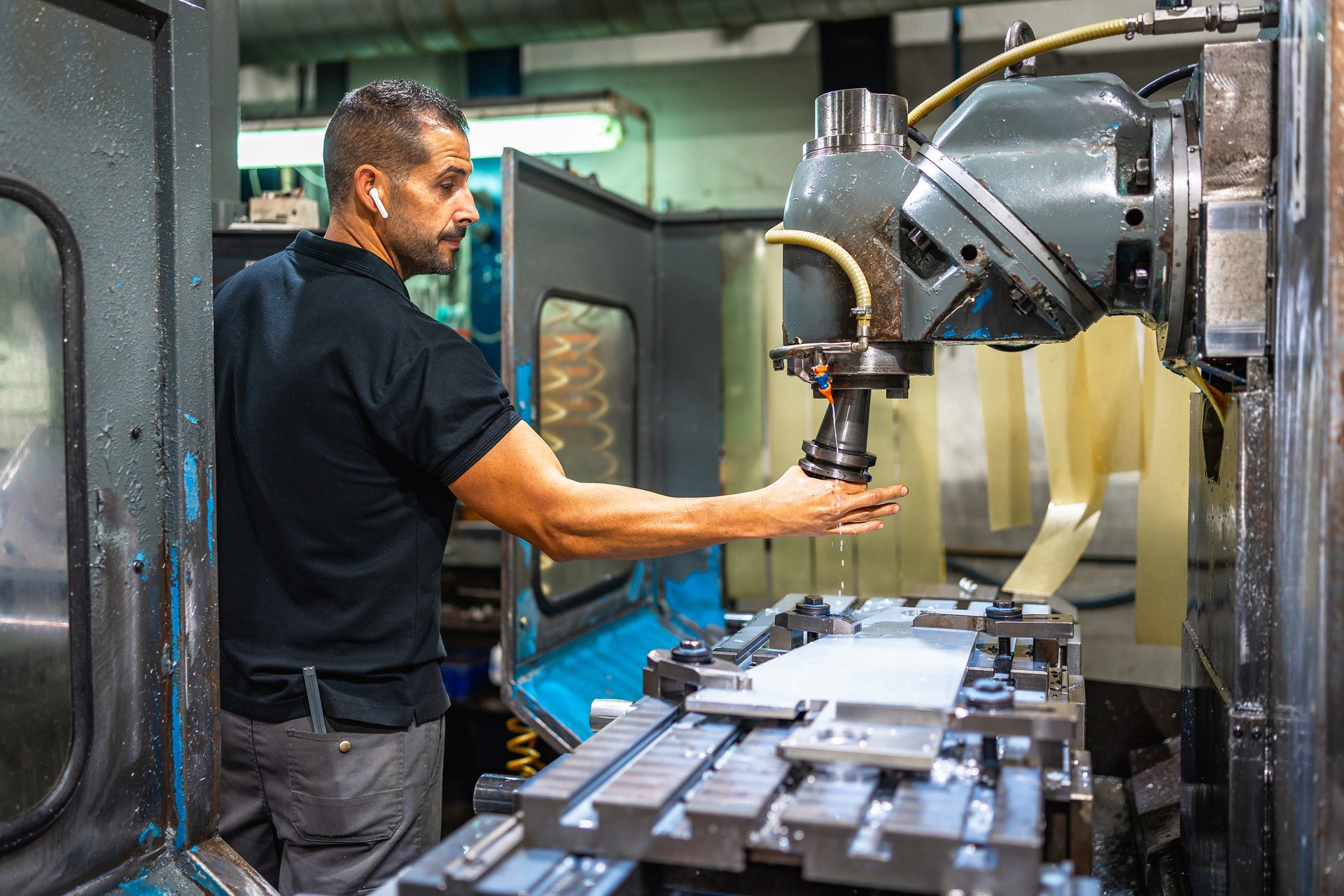H2 Deck By Bold Name
h2 xxxxxx
H1 xxxxxx
h2 xxxxx

Management

Facing cost pressures and supply chain challenges doesn’t have to be a burden manufacturers shoulder on their own. By Steve Ilmrud
Four Technologies to Consider When Navigating Economic Pressures
Management
H2 Deck Info By Paragraph Style Bold
Headline
Manufacturers are no strangers to uncertainty. Workforce shortages, supply chain disruptions, and rising material costs have made efficiency and cost control more critical than ever. Yet, this year, the signs of economic caution are heightened - for example, manufacturing activity in Texas, one of the largest industrial hubs in the U.S., declined in February, with experts citing concerns around tariffs and shifting policies as key factors. For many manufacturers, there’s a broader industry challenge: how to remain competitive amid ongoing financial pressures.
Challenges don’t always have to be major setbacks. Instead, they present an opportunity to reassess processes and identify areas where cost-saving improvements can be put into place through technology. Manufacturers across industries are already taking this approach, integrating digital solutions and new production software to streamline operations, reduce waste, and bridge workforce gaps.
Using Technology and Local Resources to Address Uncertainty
Facing cost pressures and supply chain challenges doesn’t have to be a burden manufacturers shoulder on their own. Resources like the Manufacturing Extension Partnership (MEP) program, a national network that connects manufacturers with local experts, provides guidance for supply chain resilience, sourcing, and procurement. The experts identified by the MEP help manufacturers identify cost-effective automation strategies, strengthen supplier networks, and improve operational stability.
While there are many technologies that can help manufacturers navigate uncertainty and improve profitability, digital twins, AI, metrology software, and AI-driven CNC machining optimization are top ones to consider. Each offers a path to improved cost savings, efficiency, and reduced risks, making them important tools for navigating turbulent waters.
This leads to a logical question: How exactly can these technologies help, and where should manufacturers start when implementing them?
AI to Bridge Workforce Gaps and Improve Decision-Making
There’s a lot of talk about AI replacing jobs, but in manufacturing, it’s solving a very different problem: a growing labor shortage. With millions of skilled jobs expected to go unfilled by 2030, AI isn’t about cutting workers—it’s about helping them work smarter.
Instead of feeling overwhelmed by everything AI can offer, manufacturers should focus on where AI can drive the biggest impact today. For instance:
- AI-powered workforce training: Speeds up onboarding by helping new employees make better decisions faster, minimizing errors. Especially in the metrology space - where there’s a lack of skilled programmers - AI upskilling can be very fruitful.
- Automated quality control: Detects faults immediately, preventing costly rework and ensuring product consistency.
- Optimized production scheduling: AI solutions can support factory floor and shift planning, dynamically adjusting schedules based on workforce and machine availability, as well as optimizing material flow to keep operations running smoothly.
For manufacturers just getting started with AI, again, consider small-scale implementations to get quick wins. This could look like using AI to speed up metrology programming, metrology upskilling or applying real-time sensor data to optimize processes. Like digital twins, AI is only as useful as the data it receives, but that doesn’t mean companies need perfect data to begin. Even simple operator notes or historical production trends can help AI start learning and improving over time.
Smarter CNC Machining for Cost Control and Efficiency
For industries heavily dependent on CNC machining—such as aerospace, automotive, and medical—rising material and labor costs are making precision and efficiency increasingly important. Many have recently turned to advanced CAM (Computer-Aided Manufacturing) software, to maximize processes and reduce costs.
In fact, in working with Hexagon on similar solutions, Addison Machine Engineering saw up to a 15% increase in profitability and a 97% reduction in inspection time by leveraging advanced CAM technology.
Other benefits of smarter CNC Machining include:
- Automated programming and optimized toolpaths: Reduces the overall reliance on manual programming, which reduces human error and improves efficiency – especially at a time when finding new skilled workers is a challenge.
- Improved machine and tool lifecycle: Intelligent toolpath optimization reduces tool wear, cutting down on replacement costs and increasing the lifespan of machines.
- AI-driven CNC simulation for validating processes: Allows manufacturers to fine-tune machine parameters before production begins, reducing setup time and ensuring accuracy on the first attempt.
For manufacturers still reliant on manual programming, the best first step is to standardize CNC programming and introduce AI-driven automation. Automating high-variability areas—such as tooling decisions or multi-machine synchronization—can immediately improve efficiency and reduce costs. Additionally, centralizing CNC programming helps address workforce shortages by allowing less experienced operators to execute complex jobs with better precision.
Metrology for Precision to Prevent Costly Reworks
Modern metrology tools—particularly those integrating AI and automation—are playing a crucial role in reducing waste as rising tariffs increase costs. Beyond production expenses, in industries like aerospace, automotive, and medical, where safety and reliability are critical, inaccurate measurements can also lead to expensive product recalls.
With this in mind, here are some of the ways metrology software can help with cost control and accuracy:
- Mesh compensation for additive manufacturing: Predicts and corrects material deformation during 3D printing, ensuring final parts match their intended design and reducing costly reprints.
- AI-driven measurement systems: Automates defect detection and quality assurance, minimizing human error and improving first-pass yield (FPY) before production moves to the next step.
- Integration with digital twins: Feeds real-time measurement data into digital twin models, allowing manufacturers to simulate and refine production parameters before they do on physical machines.
- Heat mapping and tolerance analysis: Pinpoints deviations in complex geometries, ensuring critical structures remain within engineering tolerances and reducing the risk of failures or rework.
To improve precision while controlling costs, manufacturers should start by integrating metrology earlier in production. Targeting high-variability areas—such as additive manufacturing or high-precision machining—can lead to immediate cost savings while improving quality and reducing recalls. In working with motorsports leads that compete in both NASCAR and Formula One, we’re seeing these benefits first-hand.
Digital Twins to Optimize Process, Reduce Waste and Downtime
Digital twins—virtual replicas of physical machines, processes, or products—are transforming how manufacturers approach production and planning. By creating a detailed digital model, manufacturers can test, refine, and optimize their existing processes before making any real-world changes that could be costly. This isn’t hyperbole; according to recent research, companies using digital twins cut costs by an average of 19%.
Here are some of the ways digital twins can help manufacturers with cost control:
- Minimizing waste and material costs: By simulating production runs before committing to expensive materials, manufacturers can identify possible issues early, reducing waste and avoiding costly rework.
- Extending equipment lifespan: Predictive maintenance, based on constant real-time data from digital twins, helps prevent unexpected machine failures, reducing costly repairs and revenue losses from downtime.
- Improving allocation of resources: Digital twins can help to optimize workflows and overall operations, reducing inefficiencies and cutting costs.
For manufacturers new to digital twins, the best place to start is by applying them to high-cost or high-waste areas, such as predictive maintenance, workflow optimization, or quality control. A small-scale implementation—such as monitoring a single machine—can provide quick ROI while reducing inefficiencies and waste. Over time, insights from these initial applications can guide wider implementation, helping manufacturers improve decision-making without disrupting existing processes.
The Path Forward
In a historically challenging industry, economic pressures will always be just one of the many roadblocks manufacturers need to deal with, but those who embrace new technologies will be in the best position to adapt. Digital twins, AI, AI-driven CNC machining solutions, and metrology are just a few of the technologies manufacturers should look to for efficiency, cost control, and competitiveness.
It’s important to remember that adoption doesn’t have to be overwhelming. Instead, manufacturers can start with small, targeted implementations—a digital twin for a single process, an AI-powered quality control tool, an automated metrology system, or AI-driven CAM software for machining efficiency—and scale over time.
